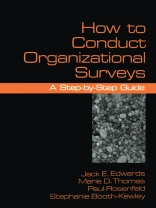A manufacturing company is downsizing and wants to know the impact on employee morale. A computer corporation is considering moving its headquarters and needs to determine how many employees intend to relocate. A multinational consulting firm has had a rash of sexual harassment complaints and seeks to determine the extent of the problem. To address these and other business-related issues, organizations are increasingly turning to surveys. Surveys are popular in organizations because–when done properly–they can provide accurate information about major organizational challenges, especially as the technology of surveys rapidly advances. Taking these issues into consideration, How to Conduct Organizational Surveys offers a practical, step-by-step guide. Anyone trying to make the transition from theory to practice will benefit greatly from this how-to guide. How to Conduct Organizational Surveys is also written for researchers who need to fine-tune their surveying skills.
Table of Content
Organizational Surveys
An Overview
Identifying Survey Content
Creating the Survey, Part One
Writing Survey Items
Creating the Survey, Part Two
Response Alternatives, Item Order, Survey Length, and Response Biases
Selecting Survey Respondents
Organizational Survey Administration
Fielding the Survey
Monitoring and Maximizing Response Rates
Data Processing
Analyzing Data and Interpreting Results
Presentation of Survey Findings
About the author
In addition to editing this book, Jack Edwards has published two survey books cited in the Recommended Readings section of this chapter. He is currently an Assistant Director in the Office of Applied Research and Methods at the U.S. General Accounting Office, Washington, DC. His prior positions include Chief of the Personnel Survey Branch at the Defense Manpower Data Center and tenured Associate Professor at the Illinois Institute of Technology.
(The opinions expressed in this article are those of the authors and do not necessarily reflect the views of the U.S. General Accounting Office.)












